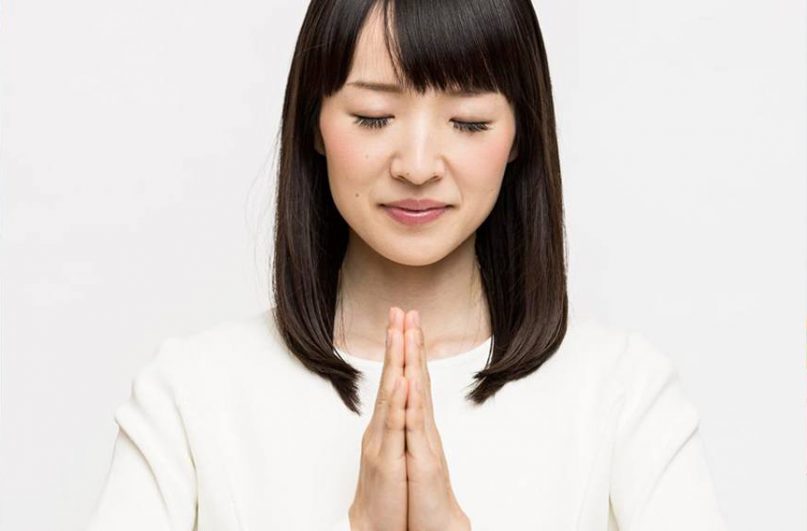(RNS) — “Does it spark joy?”
Since the release of the 2019 Netflix documentary “Tidying Up” with Marie Kondo, people across the globe have been inspired to take hold of each of their possessions and consider this simple but enigmatic question.
If the answer is no, then Marie Kondo encourages us to thank the item for its service and let it go.
The “KonMari method” for decluttering and organizing domestic goods, so named after its illustrious founder, was already a cultural phenomenon before Netflix brought it to mainstream American audiences. Originating from a single volume published in Japanese in 2011, the KonMari empire now spans podcasts, training programs and a global network of certified decluttering consultants.
As an emerging social movement, disposing of one’s goods en masse has been interrogated for its impacts on the environment, second-hand economies and people’s psychological well-being.
As with “Pokémon Go,” Hayao Miyazaki films and other Japanese popular culture phenomena that have gripped the global imagination, significant media attention has been devoted to uncovering the “religious origins” of this trend. This attention is mostly focused on the mysterious “sparks joy” phrase and the cosmology of human-object relations it introduces.
In these reports, the KonMari method is often said to be grounded in Shintoism, Japan’s indigenous system of ritual practice. Whilst the definition (and doctrine) of Shintoism is highly contested, Western media coverage usually takes it wholesale to be animism, which teaches that the material world is inhabited by kami, or spirits, such that living a good life means residing in harmony with these spirits. Buddhist teachings about the dependent origination of all existence have also been used to illuminate the enchanted domestic landscape that Kondo describes.

Marie Kondo. Photo courtesy of Netflix
Kondo’s practice of “greeting the house” before commencing cleaning, “waking up” books by tapping their spines, and even her neat (read, “pure”) dress have all been interpreted as evidence of the animism in her work. Much has been made, too, of Kondo’s part-time job as a shrine attendant, or miko, despite this being a relatively popular casual job for female high school students. Indeed, Kondo herself commented in a 2015 Reddit “Ask Me Anything” forum, “It (Shintoism) influences me, but not as strongly as you might think.”
It’s true that Japan’s public conversation also abounds with claims about a unique, monolithic national character, which frequently invokes Shintoism and sometimes Buddhism. Such generalizations are untethered from empirical studies of contemporary life and religious practice. But the Western media’s tendency to seek out religious origins for Asian popular culture phenomena can, in its worst excesses, be understood as an Orientalist reading of the Japanese people as motivated by mystical forces or irrational beliefs.
Indeed, Kondo’s joy-driven minimalism is just the latest iteration of a Japanese domestic management practice intersecting with religion.
Before “spark joy,” there was mottainai.
This similarly enigmatic phrase, which can be glossed as “Oh, what a waste!,” describes a feeling of guilt or sadness when disposing of something before its potential utility has been exhausted. A heightened consciousness of mottainai might inspire someone to mend or repurpose goods, and, by extension, consider the ecological impacts of one’s consumption.
In her wonderful new book, “Waste: Consuming Postwar Japan,” Eiko Maruko Siniawer describes how, at the turn of the 21st century, mottainai was deployed as a lost Japanese virtue, recalling post-World War II frugality as a means of tackling the contemporary problems of mass waste and a perceived pathology of affluence. Mottainai later gained purchase on a global stage, entering into United Nations environmentalist discourses via the efforts of activist Wangari Maathai. Like “spark joy,” mottainai advocates are evangelists for an attitude of respect toward the intrinsic value of things.
KonMari is significantly more positive about disposal. She sidesteps the environmental concerns raised by mottainai to focus on the impact of retention and disposal on personal emotional health. She suggests that honing one’s skills in strategic investment in goods — learning what “sparks joy” for us — can help us de-invest from what is extraneous. She doesn’t ignore the feelings of guilt; she proposes to remedy them by “thanking” objects for their service.
It is in this that I see the greatest potential resonance between the KonMari method and popular religious practice in Japan, specifically the rite of Kuyō.
In contemporary Japan, Kuyō is primarily associated with funerary rites and is best described as a syncretic, vernacular rite of venerating the dead and easing their separation from the living. Since the 19th century, temples have also held Kuyō rites for animals, professional tools and domestic objects (e.g., whales, needles and dolls).
More recently, commercial Kuyō services have emerged, promising customers to dispose of their unwanted goods and resolve any lingering ties with the living. These companies often employ Buddhist priests to conduct rites on unwanted items, from teddy bears to toasters. (These services remain a marginal practice: Just as often one finds bears and toasters tossed to the curb with the trash.)
But religious interpretations of pop-culture phenomena demand caution, particularly when we claim that we can thereby understand people’s internal motivations. The KonMari method is as Shinto (or Buddhist), in other words, as detox diets and intermittent fasting are Christian. That is to say, both phenomena can be fruitfully examined against a background of religious thought and practice that is always constructed, contested and denied.
Simply reducing the KonMari method to animism or Buddhism sparks no joy for me.
(Hannah Gould is a museum curator working in the areas of religion, material culture and death and a Ph.D. candidate in anthropology at the University of Melbourne. This article originally appeared in Sightings, a publication of the Martin Marty Center for the Public Understanding of Religion at the University of Chicago Divinity School. The views expressed in this commentary do not necessarily represent those of Religion News Service.)





